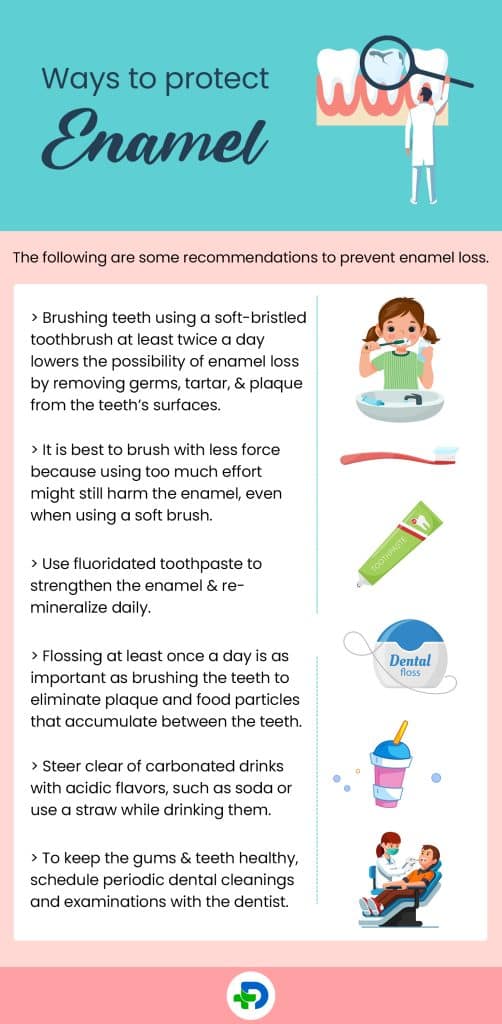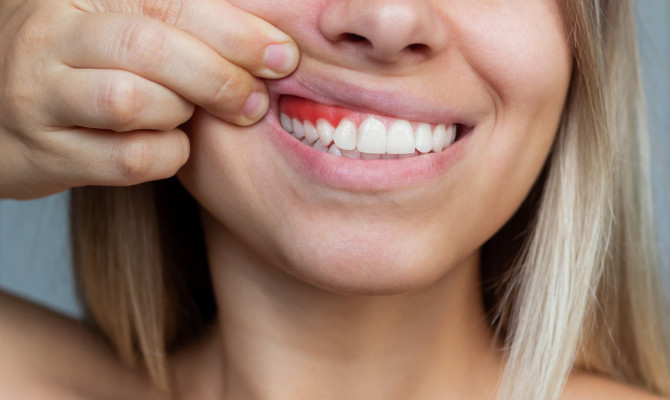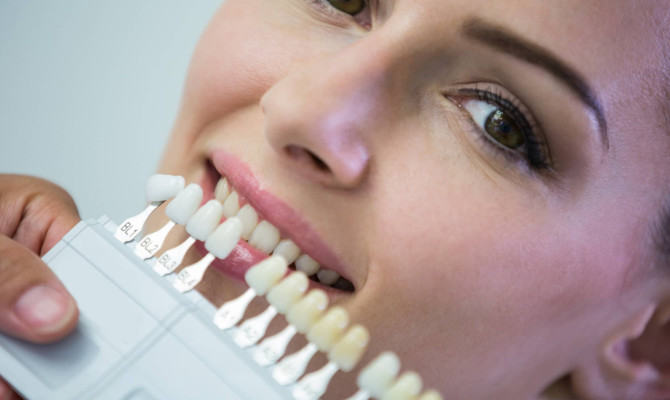Enamel : Understanding the structure, loss, and protection

- Enamel
- 22 Aug 2023
Overview
What is enamel?
Tooth enamel is the most rigid component in the human body. Calcium and phosphorus combine to create tiny crystals, which account for 95% of the enamel. The remaining structure comprises 4% water and 1% protein. It is white to off-white and is an extremely tough, highly mineralized substance that serves as a barrier to safeguard the teeth but is prone to deterioration, particularly from acids from food and drink. The functions of tooth enamel, causes and signs of enamel loss, and ways to protect and treat it are all covered in this article.

Structure
Understanding the tooth structure
Our teeth comprise two parts
- Crown – the tooth’s portion which is generally visible in the mouth, above the gums.1Structure| Researched based study from Nlm.nih.gov
- Root – the portion of the tooth the gums cover and the jaw bones hold in place.
There are four primary layers in a tooth
- Enamel – a solid defense layer covering the entire tooth crown.
- Dentin – found immediately beneath the enamel. Although dentin is not as strong as enamel, it forms the foundation of a tooth. Cavities are more likely when dentin is exposed by lacking enamel.
- Cementum – a completely mineralized tissue covering the root surface. 2Structure| Researched based study from Nlm.nih.gov It aids in safely anchoring the tooth in the jaw alongside the periodontal ligament.
- Pulp – the tooth’s deepest layer. It has connective tissues, blood vessels, and nerves. 3Structure| Researched based study from Clevelandclinic.org
Functions
Functions of enamel
The enamel shields the pulp and dentin, two of the tooth’s inner layers, from
- Bacteria that cause cavities.
- Dental deterioration.
- Sensitivity to heat or cold.4Functions| Researched based study from Nlm.nih.gov
- Acidic foods and drinks.
Enamel loss
Causes of enamel loss
Loss of tooth enamel can be caused by some circumstances including
- Genetic reason – some people rarely have genetic issues that make their enamel form insufficient or thinner than average.
- Too much pressure when brushing the teeth or using rough bristles might harm the enamel.
- Bruxism – the habit of clenching or grinding one’s teeth.
- Health conditions – such as dry mouth, reflux of acid, or other gastrointestinal issues.
- An eating disorder – tooth erosion brought on by an eating problem like bulimia nervosa in which self-inflicted vomiting occurs.5Enamel loss| Researched based study from Betterhealth.vic.gov.au
- Fracture or chip off – when someone chews on anything hard, such as a bottle cap, or falls accidentally, the enamel may break or chip off.
- Acidic drinks – consumption of too many acidic or sugary beverages such as concentrated fruit juices, soda, and other sweetened drinks can cause enamel to disintegrate.
- Overindulging in starchy, sweet, acidic, sticky, or sticky foods.
- Some dental procedures – including restorations, may require the removal of partial enamel to obtain access to the deeper decay. Or techniques like acid etching and dental whitening could harm some teeth.
Symptoms
Symptoms of enamel damage:
The following signs and symptoms can be seen if the enamel is damaged
Sensitivity
- In those with enamel loss, certain foods or drinks ingested hot or cold may induce sensitivity or pain. Sensitivity may progress as additional enamel is lost later because of aging or other circumstances.
Visible cracks or fractures of a tooth
- The tooth’s edges get crooked and serrated6Symptoms| Researched based study from Nlm.nih.gov
Abnormally smooth and shiny tooth
- May be a sign of mineral loss via erosion. The surfaces of the regular teeth are textured.
Discolored tooth
- As the enamel wears away, the teeth begin to seem more yellow as the color of the dentin is seen through.
Progressive tooth decay
- As the underlying structures are more vulnerable to infections or cavities. Additionally, the germs can quickly enter the pulp if the enamel is removed.
Tooth infections
- Infections like abscesses can develop as dental decay spreads and penetrates the tooth, affecting the pulp’s tiny nerve fibers and the surrounding structures.
Protection

Ways to protect enamel
The following are some recommendations to prevent enamel loss
- Brushing teeth using a soft-bristled toothbrush at least twice a day lowers the possibility of enamel loss by removing germs, tartar, and plaque from the teeth’s surfaces.
- It is best to brush with less force because using too much effort might still harm the enamel, even when using a soft brush.
- Use fluoridated toothpaste to strengthen the enamel and re-mineralize daily.
- Flossing at least once a day is as important as brushing the teeth to eliminate plaque and food particles that accumulate between the teeth.
- To stop further enamel erosion and medical diseases, including dry mouth, bulimia, or digestive issues, treated promptly as possible.
- If a person tends to gnaw or grind their teeth while sleeping or during moments caused by anxiety or anger, buying mouthguards from a dental office or a drugstore may help avoid enamel damage.
- Get dental sealants – they are a thin, plastic-like coating painted on the tooth surfaces that bite or chew food. They cover the teeth from plaque, tartar, and dangerous bacteria like tiny raincoats.7Protection| Researched based study from Cdc.gov
- Steer clear of carbonated drinks with acidic flavors, such as soda or use a straw while drinking them.
- Keep sipping water to cleanse away bacteria and food particles. In people with dry mouths, adequate hydration can also aid in lowering the chance of enamel loss.
- Chew xylitol-containing sugar alcohol that is sugar-free gum. Saliva production is increased, as a result, helping to maintain good enamel.
- To keep the gums and teeth healthy, schedule periodic dental cleanings and examinations with the dentist.
Treatment
Treating enamel loss
Treatment of tooth enamel loss may include
Re-mineralization
- To re-mineralize the enamel, dentists may administer fluoride treatments using fluorides in liquids, gels, varnishes, or sealants.8Treatment| Researched based study from Nlm.nih.gov
- Additionally, fluoride mouthwash and toothpaste may be suggested by the dentist.
Tooth filling or restoration
- Dentists can repair enamel that has been slightly worn away or developed a small cavity. However, they can develop into larger cavities and cause infections or uncomfortable abscesses if left untreated.
- The dentist may also use materials that are tooth-colored to repair enamel fractures.
Dental crowns or caps
- The dentist might suggest applying a dental crown or veneers to the tooth if enamel loss is severe as they shield the tooth from further damage.
- Crowns can be of various forms based on the material used to produce them namely ceramic crowns, porcelain fused to metal (PFM) crowns, full metal crowns, and all-resin crowns, etc. 9Treatment| Researched based study from Clevelandclinic.org
Takeaway
Key Takeaways
Despite its hardness, enamel is not indestructible. Remember that, unlike bone structures in the body, enamel cannot regrow once it has been broken or removed. Therefore, like many other issues, preventing enamel loss is preferable to treating it. Practicing good oral hygiene and visiting a dentist twice a year may help maintain enamel health and prevent further loss. Additionally, the dentist can recommend usage of fluoride-containing products and teach how to strengthen or re-mineralize the tooth enamel at home.
Any feedback on this article?
 This Articles content was accurate
This Articles content was accurate Very Informative Article
Very Informative Article I have a question or a comment
I have a question or a comment
 This article contains inaccurate content
This article contains inaccurate content This article was not helpful
This article was not helpful I have a question or a comment
I have a question or a comment
We appreciate your helpful feedback!
Checkout our social pages
References
-
National Library of Medicine
Anatomy, Head and Neck, Teeth | Structure
-
National Library of Medicine
Histology of human cementum: Its structure, function, and development | Structure
-
Cleveland Clinic
Tooth Pulp | Structure
-
National Library of Medicine
Dental Enamel Formation and Implications for Oral Health and Disease | Functions
-
Better Health Channel
Dental erosion | Causes
-
National Library of Medicine
Tooth Fracture | Causes
-
Centers for Disease Control and Prevention
Dental Sealants | Protection
-
National Library of Medicine
Recent Advances in Dental Hard Tissue Remineralization: A Review of Literature | Treatment
-
Cleveland Clinic
Dental Crowns | Treatment




































